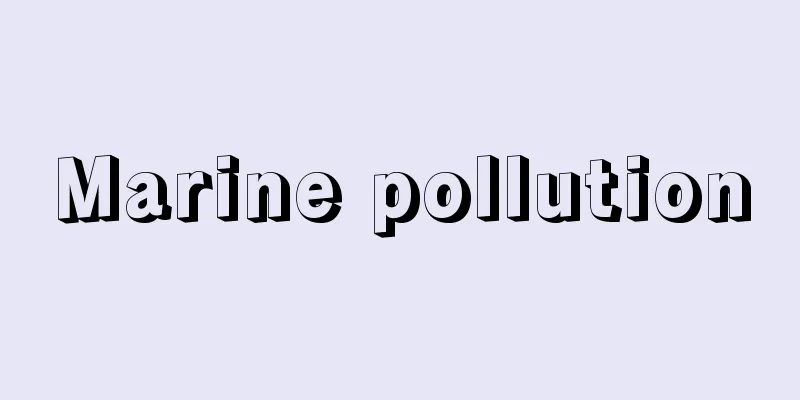Marine pollution

|
Marine pollution is defined as any substance or energy introduced directly or indirectly into the marine environment by human activities that has harmful effects on biological resources, human health, and fishing activities, as well as damaging the inherent properties of seawater and the comfort of the marine environment. This definition was created by the Joint Group of Experts on the Scientific Aspects of Marine Environmental Protection (GESAMP), a joint UN-related organization involved in marine pollution. The causes of these are called pollutants. In addition to those directly released from ships, etc. at sea, pollutants artificially released into the environment on land include those that diffuse into the atmosphere, those that are carried to the open ocean by the atmosphere, and those that are transported to estuaries, inland bays, and inland seas in groundwater and river water, and then reach the open ocean via coastal waters. The pollution of the ocean, which covers a large area of about three-quarters of the Earth's surface, is much greater from land sources than from ships, accounting for about 80% of all marine pollution. Recently, new types of land-based pollution have been discovered that are beginning to cause serious damage to marine biological resources and ecosystems, drawing renewed attention to land-based marine pollution. [Tetsuro Suzuoki] Problems with marine pollutionDuring the process of transport by river water, some of the pollutants are absorbed into the bottom sediment, and in inland bays and seas, they move and diffuse due to mixing and dilution with open ocean water. This means that the pollution level of the bottom sediment and open ocean water itself will increase gradually in comparison. The average residence time of substances in coastal waters such as inland bays and seas is estimated to be at most a few months to at most a few years. Even if the environment in coastal areas deteriorates, it is not impossible to restore the environment by restricting the inflow of pollutants and relying on natural purification processes or by using modern technologies such as dredging. On the other hand, the open ocean is a vast area that extends over 100 to 1,000 kilometers from the land, and the residence time of substances there is a long time scale of 100 or 1,000 years. This means that open ocean water has the ability to store much more substances for a long time than coastal water, or in other words, it is very difficult for concentration to change in a short time. However, when pollutants gradually accumulate and show signs of an increase in concentration levels, there is no way to restore a clean marine environment other than relying on natural forces, as can be seen from the large scale of time and space involved, and this will take a long time that exceeds the life cycle of humans. In order to protect a healthy marine environment, it is necessary to predict the effects that the gradual accumulation of pollutants from various origins in the marine environment will have on the biological ecosystem, and to continue constant monitoring so as not to be late in taking measures to prevent the addition of pollutants. [Tetsuro Suzuoki] Substances subject to marine pollutionSubstances that have already entered the marine environment, directly or indirectly, and are thought to have some effect on the environment, including in the surface waters of the open ocean and sometimes in deeper waters, include the following: [1] Artificial radioactive elements With the wide-ranging use of nuclear energy, including nuclear weapons and nuclear power generation, various artificial radioactive elements, such as several fission product nuclides ( 3H , 90Sr , 137Cs , 144Ce , etc.), inducible radioactive nuclides ( 14C , 54Mn , 60Co , etc.), and transuranium elements (Pu, Np, Cm, etc.), are currently being constantly produced on Earth. It is possible that these nuclides may leak from various stages of the nuclear fuel cycle, such as the mining and refining of uranium ore, the use of nuclear fuel in nuclear power plants, and the reprocessing of spent nuclear fuel, and that their concentration in the environment may continue to increase gradually in the future. In addition, the release of large amounts of high-level radioactivity from nuclear facility accidents has made the world aware that, although to varying degrees, it can cause serious environmental damage, as seen in the nuclear power plant accidents in the UK (Windscale, 1957), the US (Three Mile Island, 1979), Ukraine in the former Soviet Union (Chernobyl, 1986), and Japan (Fukushima, 2011). On the other hand, there have been cases in the past, such as the illegal dumping of high-level radioactive waste into the seas around Japan by the Soviet Union, and the treatment and management of nuclear materials, both before and after use, will require careful and international monitoring in the future. In addition, transuranium elements and their compounds are highly toxic chemically. Plutonium is still transported and stored in large quantities around the world as nuclear weapons and nuclear fuel, and there is concern that it will become a new source of pollution. [2] Oil It is estimated that approximately 3 to 4 million tons of oil are currently flowing into the marine environment in various forms and routes each year. As a result of the increase in the consumption of oil as an energy source and as a raw material for the petrochemical industry, the increase in marine transportation and onshore storage and refining facilities, and the development of offshore oil fields, it is not expected that the amount of oil flowing into the marine environment will decrease rapidly in the future. In addition, in the case of accidents involving tankers, offshore oil wells, or onshore facilities, as many past cases have shown, large amounts of crude oil and other substances can be spilled at once, causing particularly serious damage to the surrounding environment. Oil that enters the marine environment exists in various forms, such as floating on the sea surface as an oil film or oil lump, dissolved or dispersed in seawater, or deposited on the seabed, and gradually weathers away. Crude oil is composed of thousands of compounds with different properties, and among its components are substances such as polycyclic aromatic hydrocarbons that have extremely adverse physiological effects on living organisms. Moreover, these components are extremely stable compared to other components, and a considerable amount of them remain in the bottom sediments of sea areas that have been polluted in the past, and they are re-eluted due to erosion of the seabed, etc. This has resulted in chronic oil pollution, which has a major impact on surrounding fish, shellfish and seaweed. Many ocean-facing beaches around the world are polluted by drifting oil globs, causing serious problems such as contamination of fish and shellfish and impeding use of the coast. Oil slicks spreading on the ocean surface concentrate various artificial organic compounds, such as dichlorodiphenyltrichloroethane (DDT) and polychlorinated biphenyls (PCBs), in the film, and also interfere with the evaporation of seawater and the exchange of materials and energy between the atmosphere and the ocean. There are still many aspects of the fate of oil after it enters the ocean, such as the physical mechanisms of its movement and diffusion in the ocean, its accumulation in organisms, and its chemical decomposition process. [3] Artificial organic compounds Organochlorine compounds such as DDT and PCBs, which were used in large quantities in the past, are ubiquitous in seawater. The concentration distribution is not uniform, and relatively high concentrations of contamination have been found in mid-latitude seas in the Northern Hemisphere, corresponding to the distribution of developed countries. These compounds were used in large quantities in the past as pesticides and insecticides in ordinary households, as heat transfer media, insulation agents, additives, etc. In Japan and Western countries, their production and use have already been banned, and safer alternatives are being used, but some developing countries still use a considerable amount of DDT annually for agricultural purposes and as a measure against malaria. These substances are extremely stable compounds, and it has been pointed out that they have various residual toxicities. A considerable portion still remains on land, and these are flowing into the ocean through rivers and the atmosphere. While the concentration in seawater is about 0.1 ppt (parts per trillion) on average, it is known that marine organisms accumulate these substances in their bodies at concentrations ranging from ppb (parts per billion) to ppm (parts per million), that is, 10,000 to 10 million times the concentration. Furthermore, these substances are concentrated up the food chain to ppm levels, for example from plankton → fish → marine mammals (whales, seals, etc.). In particular, within living organisms, they are selectively concentrated in fats and oils. Looking at the use of pesticides in agricultural production, a considerable amount is still being used in both developed and developing countries to achieve higher yields. In Japan in particular, almost twice as much pesticide is used as the yield. These alternative substances will also need to be monitored closely in the future. New impacts on ecosystems of organic compounds containing chlorine are beginning to become apparent. (1) Dioxins A general term for a group of organochlorine compounds including polychlorinated dibenzo-p-dioxins (PCDDs), polychlorinated dibenzofurans (PCDFs), and coplanar PCBs (Co-PCBs), a type of PCB. Of these, about 30 isomers are being evaluated for toxicity. They are one of the by-products generated during processes such as heating, burning, and incineration, and during chemical synthesis, and are also called unintentionally produced chemicals. Their toxicity is characterized by acute lethal toxicity, teratogenicity, carcinogenicity, reproductive disorders, and immunosuppression, but the degree of toxicity varies depending on the compound. These are generated from a variety of sources, but about 80% of the total emissions are generated from incinerators of urban and industrial waste, which contain a large amount of waste plastic. These are released into the environment with flue gas and move and diffuse through the atmosphere. They have already been detected widely, mainly in soil, sediment, seafood, and human body fat. Careful monitoring of the future status and progression of contamination in soil, rivers, and oceans is required. (2) Endocrine system (endocrine) disrupting substances These are also called environmental hormones or hormone-like chemicals. They are a general term for more than several dozen types of chemical substances, including organochlorine compounds such as dioxins, organometallic compounds such as tributyltin, phthalates, alkylphenols, bisphenol A, and triazine herbicides. These substances have hormone-like structures and are known to bind incorrectly to hormone receptors, causing abnormal changes in hormone activity. They are also known to disrupt substance metabolism, inhibit the immune system, and cause carcinogenesis. It is said that these chemical substances are responsible for the increase in breast cancer incidence and the decrease in sperm count in humans, as well as the reproductive dysfunction seen in some birds, fish, and other wildlife. It is feared that the release of these substances, which disrupt the hormone systems of living organisms, into the environment may jeopardize the self-preservation and survival of species, which are important for humans and other living organisms, such as reproduction and development. At present, the actual distribution of these substances in the environment and their impact on living organisms are not yet clear. There is an urgent need to establish a monitoring system for these substances, elucidate their physiological effects and mechanisms, and establish assessments of their impact on health. [4] Heavy metals These include mercury (Hg), cadmium (Cd), silver (Ag), copper (Cu), zinc (Zn), nickel (Ni), chromium (Cr), tin (Sn), iron (Fe), manganese (Mn), aluminum (Al), and lead (Pb). All of these are harmful in both elemental and compound form, except in very small amounts. They are generally easily absorbed into the body, and some, such as copper (Cu), zinc (Zn), and cadmium (Cd), are concentrated in the body by 10,000 to 100,000 times more than in the environment. Although not heavy metals, arsenic (As), antimony (Sb), and selenium (Se) can also be added to this group in terms of environmental pollution. The annual production of heavy metals is far greater than the annual amount transported to the sea by rivers through natural processes such as weathering. These metals are transported from the coasts through rivers and industrial wastewater on the one hand, and to the open sea through the atmosphere as a result of the combustion of fossil fuels and the calcination of lime in the cement manufacturing process on the other. Heavy metals are essential resources in industrial activities and will continue to be used in the future. [5] Solid waste On the beach, sea surface and seabed, household and industrial waste such as plastics, glass and metals, which cannot decompose rapidly in the marine environment, float or deposit. It is estimated that more than several million tons of this waste is currently dumped into the ocean every year. Although the impact on the marine environment is not clearly understood, it is well known that plastics such as resin pellets (granular intermediate materials for plastic products), polystyrene foam fragments and fishing nets, which continue to float without decomposing in the marine environment, cause various damage to marine life such as seabirds, sea turtles and seals. The accumulation of solid waste on the seabed hinders the exchange of chemicals between seawater and sediments, significantly affecting the activity of seabed organisms, and there is concern that an increase in the amount of waste dumped will have a serious impact on the ecosystem of marine organisms. [6] Water pollution due to eutrophication (2) Blue tide: When plankton remains and large amounts of organic matter in sludge deposited in depressions on the seafloor (such as dredging sites and shipping lanes) are decomposed by bacteria, oxygen is consumed and hydrogen sulfide is produced through sulfate reduction. When wind causes rip currents to flow out of the bay, this mass of water on the seafloor rises to the surface at the inner part of the bay to replenish the water. When this happens, the hydrogen sulfide is oxidized and turns into sulfur and polysulfides, causing the seawater to appear milky blue or white. It emits a foul odor, is almost completely transparent, and causes the death of fish and shellfish due to lack of oxygen. (3) As a result of environmental conservation measures, including the reduction of the addition of pollutants from land that cause eutrophication, the occurrence of red tides and blue tides has been declining in recent years. However, recent red tides have been characterized by the long-term occurrence of a wide variety of plankton in many sea areas, including the open ocean. Some have pointed out that this is an indicator of biological changes in response to a marine environment that continues to accumulate pollutants over many years. [7] Thermal pollution Large amounts of water are used as cooling water for heavy industry-related factories and power plants. The efficiency of converting energy from heat to electricity in large thermal and nuclear power plants is generally said to be 30-50%, with most of the remaining losses being consumed in the form of increased temperature of the cooling water and released into the environment. This wastewater is about 10°C higher than the environmental water temperature and is called warm wastewater. In the case of cooling water used in heavy industry, although the total amount is small, high-temperature wastewater is released. Since the environmental water temperature is one of the most important habitat factors for aquatic organisms, any change in the water temperature caused by warm wastewater, even if it is only slight, can bring about significant changes in the biota. [Tetsuro Suzuoki] Measures to prevent marine pollutionInternational InitiativesThe problems of marine pollution must be addressed on a global scale. The Declaration on the Human Environment (1972) of the First United Nations Conference on the Human Environment held in Stockholm provided important guidelines for dealing with the growing environmental pollution problem. In it, the need to take all possible measures to prevent environmental pollution with cooperation from all countries was stated. In response to this, the United Nations Environment Programme (UNEP) was established and pointed out the need to develop a Global Environment Monitoring System (GEMS) to monitor all aspects of the global environment, including the atmosphere and oceans. In response to this, the Intergovernmental Oceanographic Commission (IOC) of UNESCO, the Advisory Committee of Experts on Marine Resources Research (ACMRR) of the Food and Agriculture Organization of the United Nations (FAO), the World Meteorological Organization (WMO), the World Health Organization (WHO), the International Maritime Organization (IMO), the International Atomic Energy Agency (IAEA), and the aforementioned UNEP, among others, began to actively work together to prevent pollution. As marine pollution is a broad-ranging issue, the above-mentioned organizations have formed a joint group of experts (GESAMP) to provide advice on scientific issues related to pollution. Meanwhile, specific international cooperation plans are being promoted in line with Chapter 17, "Protection and Rational Use of the Marine Environment and Marine Living Resources," of Agenda 21 (Agenda for the Renewal of the Planet), which was adopted at the 1992 United Nations Conference on Environment and Development (UNCED) (Earth Summit), which was attended by approximately 170 countries. In addition, the 1994 United Nations Convention on the Law of the Sea (UNCLOS) set out guidelines stating that "Every State in the world has an obligation to protect and conserve the marine environment and to take the necessary measures to prevent, reduce and control pollution of the marine environment." In accordance with these guidelines, international treaties for the prevention of marine pollution have been concluded or existing treaties have been revised, and national laws have also been established in each country. As a regional initiative for marine environmental conservation led by UNEP, the North-west Pacific Action Plan (NOWPAP), which covers the Yellow Sea and the Sea of Japan, was launched in 1994 as the 12th such initiative in the world. The plan was initiated by four countries - Japan, South Korea, China and Russia - and covers the Yellow Sea and the Sea of Japan. [Tetsuro Suzuoki] Domestic EffortsJapan's legal restrictions on water pollution began with the Water Quality Conservation Law and the Factory Effluent Control Law (1958). Furthermore, the Basic Law for Pollution Control (1967) and the Water Pollution Prevention Law (1970) were enacted to promote measures against the worsening pollution. In response to the London Dumping Convention (1972) on the prevention of marine pollution by dumping of waste and other materials, and the MARPOL Convention 73/78 (1973, 1978, 1997) which prohibited pollution from ships, the Law on Prevention of Marine Pollution and Maritime Disasters (Marine Pollution Prevention Law) and the Law on Disposal and Cleaning of Wastes (Waste Disposal Law) were enacted in 1970 (Showa 45). Since then, in response to international trends, laws have been enacted and revised to expand pollution prevention measures, such as the Basic Law for the Environment (1995) which integrated the Basic Law for Pollution Control, and efforts have been made to improve and strengthen environmental conservation administration in general. [Tetsuro Suzuoki] Present and future of marine pollution monitoringIn accordance with international treaties and domestic laws, national government agencies, local governments, research institutes, universities, and private volunteers who are closely involved with the marine environment are conducting a wide range of activities, including marine pollution observation, research and studies, technological development, prevention measures, establishment of pollutant control systems, and surveillance and control. For example, under the Ministry of Land, Infrastructure, Transport and Tourism, the Japan Meteorological Agency conducts marine background pollution observations in the seas off the coast of Japan and the Northwest Pacific Ocean in order to prevent marine pollution and protect the marine environment, based on the Marine Pollution Prevention Act, while the Japan Coast Guard conducts surveys and observations in the seas off the coast of Japan and major bays to monitor and control marine pollution caused by waste and other substances in surrounding sea areas. The Ministry of the Environment conducts surveys of marine pollution, mainly in coastal areas, based on the Water Pollution Prevention Act and the Basic Environment Act, and the Ministry of Agriculture, Forestry and Fisheries (Fisheries Agency) also conducts surveys from the perspective of environmental conservation of marine resources such as fishing grounds and beaches. The results of the surveys and observations are published in their respective annual reports and are also reported to international organizations on an ongoing basis. In developed countries such as Japan, environmental conservation laws and prevention technologies have been established, and strict regulations on the discharge of polluting substances have been put in place, so the situation is certainly improving. However, more thorough research, observation, and monitoring of the marine environment is necessary to detect new types of pollution that are expected to appear in the future. In developing countries, rapid economic development without a well-established environmental conservation system will likely lead to various types of pollution, and the discharge of harmful substances could have a serious impact on the marine environment. As ocean currents such as the Kuroshio Current and the Oyashio Current reach Japan from the north and south, it is important to continue to thoroughly monitor the surrounding marine environment to prevent transboundary pollution from neighboring countries. [Tetsuro Suzuoki] "Kawasaki Ken, 'Environmental Studies of the Ocean' (1993, Shin Nihon Shuppansha)" ▽ "Harashima Sho and Kunai Masayuki, 'The Functions of the Ocean and Marine Pollution' (1997, Shokabo)" ▽ "100 Crises to the Ocean Environment' (ed. DOBIS Editorial Committee, Ocean Research Institute, University of Tokyo, 2006, Tokyo Shoseki)" ▽ "Kunai Masayuki, 'The Color of the Ocean Tells Us About the Global Environment - Marine Pollution and the Future of Water' (PHP Shinsho)" [References] | | | | | | | | | | | | | | |Source: Shogakukan Encyclopedia Nipponica About Encyclopedia Nipponica Information | Legend |
|
人間活動によって直接あるいは間接に、海洋環境に持ち込まれた物質あるいはエネルギーが、生物資源、人間の健康および水産漁業などの活動に有害な影響を及ぼし、また海水の本来の性質や海洋環境の快適さを損なう場合を海洋の汚染という。これは海洋汚染にかかわる国連関係機関合同の、海洋環境保護の科学的事項に関する専門家合同グループGESAMP(The Joint Group of Experts on the Scientific Aspects of Marine Environmental Protection)によって定義されたものである。これらの原因となるものが汚染物質である。洋上で直接船舶等から放出されるもののほかに、陸上で環境に人為的に放出された汚染物質には、大気中に拡散するもの、さらに大気により外洋に運ばれるもの、地下水、河川水などで河口域、内湾、内海に移送され、沿岸海域を経て外洋にまで達するものがある。地球全表面の約4分の3の大きな面積を占める海洋の汚染は、陸上起源によるものが船舶起源よりはるかに大きくて、海洋汚染全体の約80%を占めている。最近になって新しいタイプの陸起源の汚染が海洋環境の生物資源や生態系に重大な損害を与え始めていることがみいだされ、陸起源の海洋の汚染が改めて注目されている。 [鈴置哲朗] 海洋汚染の問題点河川水などによる移送の過程で、汚染物質の一部は底質中へ取り込まれ、また、内湾や内海などでは外洋の水との混合、希釈によって移動拡散する。このことは逆に、底質や外洋水自体の汚染レベルが相対的に徐々に上昇することを意味する。内湾、内海など沿岸水中の物質の平均的な滞留時間は、せいぜい数か月から長くても数年程度と見積もられている。沿岸域では環境の悪化を生じた場合にも、汚染物質の流入規制をして自然の浄化過程によるか、浚渫(しゅんせつ)などの近代技術を併用するかなどして環境の回復を図ることが不可能ではない。一方、外洋は、陸から100~1000キロメートルを超えて広がる広大な部分で、そのなかでの物質の滞留時間は100年とか1000年という長い時間尺度をもつようになる。これは、外洋水が沿岸水に比べてはるかに多量の物質を長時間にわたり蓄えうる能力をもつことを、いいかえれば短時間では濃度の変化はきわめておこりにくいことを意味している。しかし、汚染物質が徐々に蓄積され、その濃度レベルに上昇の徴候が現れたときには、その時間・空間的な規模の大きさからもわかるように、自然の力に頼る以外には清浄な海の環境へ戻す手だてはなく、人間のライフ・サイクルを超えた長い時間を要する。さまざまの起源をもつ汚染物質が海洋環境で少しずつ蓄積を続けることにより生物生態系にどのような影響が現れるかを予測し、汚染物質の付加を防止するための対処に遅れを生じないように絶えず監視を続けることが、健全な海洋環境を守るために必要である。 [鈴置哲朗] 海洋汚染の対象物質すでに直接間接に海洋環境に入り、外洋の表面水や、ときとして深層にまで及んでいるものを含めて、環境になんらかの影響を及ぼすと考えられる物質には次のようなものがある。 〔1〕人工放射性元素 核兵器、原子力発電など原子力エネルギーの多方面にわたる利用に伴って、いくつかの核分裂生成核種(3H,90Sr,137Cs,144Ceなど)、誘導放射性核種(14C,54Mn,60Coなど)、超ウラン元素(Pu,Np,Cmなど)といったさまざまの人工放射性元素が現在、地球上で常時生成されている。これらの核種は、ウラン鉱の採掘とその精錬、核燃料としての原子力発電所での使用、使用済み核燃料の再処理という核燃料サイクル中の各過程から漏出して、環境における濃度レベルを今後も徐々に高める可能性がないとはいえない。また、原子力施設の事故に伴う大量の高レベル放射能の放出は、イギリス(ウィンズケール、1957年)、アメリカ(スリーマイル島、1979年)、旧ソ連のウクライナ(チェルノブイリ、1986年)および日本(福島、2011年)での原子力発電所の事故にも見られるように、程度の差はあれ重大な環境破壊をもたらすことを世界に知らしめた。一方過去には、ソ連による高レベル放射性廃棄物の日本周辺海域への不法投棄などの事例もあり、核物質の処理と管理については使用の前後を問わず今後の慎重かつ国際的な監視が必要である。また、超ウラン元素とそれらの化合物は化学的にも毒性の強い物質である。プルトニウムは現在でも地球上で広く大量に核兵器や核燃料として輸送や貯蔵をされており、新たな汚染源となることが憂慮される。 〔2〕石油 現在、年間およそ300~400万トンの石油がさまざまな形や経路で海洋環境に流入していると推定されている。エネルギー源として、また石油化学工業の原料としての石油消費量の増大に伴う海上輸送量や陸上貯蔵・精製施設の増加、また海底油田の開発などの結果、海洋環境への流入量は今後急速に減少するとは考えられない。また、タンカー、海洋油井あるいは陸上施設の事故の場合には、これまでの多くの事例が示しているように一度に大量の原油などが流出し、周辺の環境にとくに深刻な打撃を与える。海洋環境に入った石油は、油膜あるいは油塊として海面上に浮遊するもの、海水中に溶解・分散するもの、および海底に沈積するものなど多様な形で存在しながら徐々に風化する。原油は数千の異なる性質をもつ化合物から構成されるが、その構成成分のなかには、多環芳香族炭化水素のように生体にきわめて悪い生理作用を及ぼす物質が含まれている。しかもこれらは他の構成成分に比べてきわめて安定であり、過去に汚染された海域の底質中にはかなりの量が残存し、海底の侵食などによってこれらが再溶出する。そのために慢性的な油汚染を生じ、周辺の魚介類や海藻などに大きな影響を与えている。世界中の多くの外洋に面する海浜は漂着油塊によって汚染され、魚介類の汚染や海岸利用の障害などの深刻な問題を生じている。海面上に拡散している油膜は、ジクロロジフェニルトリクロロエタン(DDT)やポリ塩化ビフェニル(PCB)などさまざまの人工有機化合物を膜中に濃縮したり、また、海水の蒸発や大気―海洋間の物質・エネルギー交換などを妨害したりする。石油の海洋における移動や拡散などの物理的な機構や、生物への蓄積、化学的な分解過程など、流入後の消長についてはまだよくわかっていない点が多い。 〔3〕人工有機化合物 過去に大量に使用されたDDT、PCBなどの有機塩素系化合物が、海水中にも普遍的に存在する。濃度分布は一様ではなく、先進工業国の分布に対応して北半球中緯度海域で比較的高濃度の汚染が認められている。これらは過去に農薬や一般家庭での殺虫剤として、また熱媒体、絶縁剤、添加剤などとしてともに大量に利用されたものである。日本や欧米の諸国ではこれらの製造および使用はすでに禁止され、より安全性の高い代替物質を使用しているが、それでも一部途上国では農業目的として、また、マラリア対策として年間かなりの量のDDTが現在なお使用されている。これらの物質はきわめて安定した化合物である上に、さまざまな残留毒性をもつことが指摘されている。かなりの部分がいまなお陸上にも残存し、それらが河川や大気を通じて海洋へ流入している。海水中の濃度が平均0.1ppt(1兆分率)程度であるのに対して、海洋生物中の濃度はppb(10億分率)からppm(百万分率)つまり1万倍から1000万倍の範囲でこれらの物質を体内に蓄積していることが知られている。また、これらは食物連鎖によって、たとえば、プランクトン→魚類→海産哺乳(ほにゅう)動物(クジラ、アザラシなど)の順でppmレベルまで濃縮される。とくに、生体内では油脂中に選択的に濃縮される。農業生産における殺虫剤の使用状況をみると、より高い収量を得るために先進国、途上国を問わず、かなりの量が依然として利用されている。とくに日本では収量のほぼ2倍の殺虫剤が使用されている。これら代替物質についても今後の十分な監視が必要であろう。塩素を含む有機化合物については生態系への新たな影響が顕在化しはじめている。 (1)ダイオキシン類 ポリ塩化ジベンゾ-p-ジオキシン(PCDD)、ポリ塩化ジベンゾフラン(PCDF)、PCBの一種であるコプラナーPCB(Co-PCB)などを含めた一群の有機塩素系化合物の総称であり、これらのうち約30種の異性体が毒性の評価対象とされている。加熱、燃焼、焼却などの過程や化学合成過程で生成される副生成物の一つで、非意図的生成化学物質ともよばれている。その毒性は急性致死毒性、催奇形性、発癌(はつがん)性、また、生殖障害や免疫抑制などによって特徴づけられるが、その程度は化合物それぞれによって異なる。これらの発生源は多様であるが、そのうち廃プラスチックを大量に含む都市ごみや産業廃棄物の焼却炉から発生するものが総排出量のおよそ80%を占めている。これらは排煙とともに環境に放出され、大気を通じて移動拡散する。すでに土壌、底質、魚介類、ヒトの体脂肪を中心に広範に検出されている。今後の土壌、河川、海洋での汚染の状況とその推移に注意深い監視が必要とされている。 (2)内分泌系(エンドクリン)攪乱(かくらん)物質 環境ホルモンあるいはホルモン類似化学物質ともよばれている。ダイオキシンなどの有機塩素系化合物、トリブチルスズなどの有機金属化合物、フタル酸エステル、アルキルフェノール類、ビスフェノールAおよびトリアジン系除草剤など数十種類以上の化学物質の総称である。これらはホルモン類似の構造をもつためにホルモン受容体に誤って結合しホルモン活性に異常な変化を与えることが知られている。また、物質代謝の攪乱や免疫系の阻害、発癌作用などをもたらすとされている。ヒトの乳癌発生率の上昇や精子数の減少、さらにある種の鳥類、魚介類など野生生物にみられる生殖機能障害はこれらの化学物質によるものといわれている。生物のホルモンシステムを攪乱するこれらの物質が環境に放出された結果、生殖や発育などというヒトや他の生物にとって重要な自己の保存や種の存続が危うくされるのではないかと危惧(きぐ)されている。現状では環境中での分布や生物への影響の実態はまだ明確でない。これらの物質のモニタリング体制の整備、生理作用とそのメカニズムの解明、健康への影響評価の確立が急がれる。 〔4〕重金属 水銀HgやカドミウムCdをはじめ、銀Ag、銅Cu、亜鉛Zn、ニッケルNi、クロムCr、スズSn、鉄Fe、マンガンMn、アルミニウムAl、鉛Pbなどがある。これらは極微量の場合を除けば元素の形でも化合物の形でも例外なく有害である。一般に生体中に取り込まれやすく、銅Cu、亜鉛Zn、カドミウムCdなどのように環境に比べて1万~10万倍も生体中に濃縮されるものもある。また重金属ではないが、ヒ素As、アンチモンSb、セレンSeなども環境汚染の面からみると、この仲間に加えてもよい。重金属などについては、風化など自然の過程のなかで河川により海に運ばれる年間量よりも、鉱業としての年間生産量のほうがはるかに大きくなっている。これらの金属は、一方では河川や工場廃水を通じて沿岸から、他方では化石燃料の燃焼やセメント製造過程での石灰の焼成の結果として大気経由で外洋へ移送されている。産業活動などにおいて重金属は必要不可欠な資源であり、今後も連続的に使用されよう。 〔5〕固形の廃棄物 海浜、海面、海底には、プラスチック、ガラス、金属など海洋環境では急速に分解できない生活・産業廃棄物が浮遊または沈積している。現在年間数百万トン以上のこれら廃棄物が海洋へ投棄されていると推定される。海洋環境への影響は明確に把握されていないが、少なくともレジンペレット(プラスチック製品の中間材料で粒状のもの)や発泡スチロールの破片や漁網など海洋環境ではほとんど分解されないで浮遊を続けるプラスチック類が、海鳥、ウミガメ、アザラシなどの海洋生物にさまざまな障害を与えていることはよく知られている。海底での固体廃棄物の蓄積は、海水と堆積物の間の化学物質の交換を妨げ、海底生物の活動に大きな影響を与えるなど、投棄量の増大は海底の生物生態系に深刻な影響を及ぼすことが懸念される。 〔6〕富栄養化による水質汚濁 (2)青潮 海底の窪地(くぼち)(浚渫跡や航路など)に沈積したプランクトンの死骸(しがい)や汚泥中の大量の有機物がバクテリアによって分解される際に酸素が消費され、硫酸還元により硫化水素を生じる。風による湾外への離岸流が生じると、海底のこの水塊がそれを補うために湾奥部の表面に浮上する。このとき硫化水素が酸化されて硫黄(いおう)や多硫化物に変化し、海水が乳青色や乳白色に見える現象である。異臭を発し、透明度はほとんどなく、酸欠状態により魚貝類を死滅させる。 (3)富栄養化をもたらす陸上からの汚染物質付加の削減をはじめとする環境保全施策の結果として、近年の赤潮・青潮の発生件数は減少気味である。しかし、このところの赤潮には多種多様なプランクトンが外洋を含む多くの海域で長期にわたって発生するという特徴が現れている。これは長い年月にわたって汚染物質を蓄積し続ける海洋環境に対応する生物的な変化の指標の一つという指摘もある。 〔7〕熱汚染 重工業関連の工場や発電所などの冷却水として大量の水が利用されている。大型の火力・原子力発電所における熱から電気へのエネルギーの変換効率は一般に30~50%といわれ、その他の損失分はほとんど冷却水の温度上昇の形で消費されて環境へ放出される。この排水は環境の水温に比べておよそ10℃前後高くなり温排水とよばれている。重工業に用いられる冷却水の場合、総量は少ないが高温の排水が放出される。環境の水温は水生の生物にとってもっとも重要な生息環境因子の一つであるので、温排水による水温環境の変化は、それがたとえわずかであっても生物相に重大な変化をもたらすことになる。 [鈴置哲朗] 海洋汚染防止対策国際的な取り組み海洋汚染の諸問題は、全地球的な規模で対処しなければならない。増大する環境汚染に対する国際的な動きとして、その後の汚染問題の対処への重要な指針を与えたのがストックホルムで開かれた第1回国連人間環境会議の「人間環境宣言」(1972)である。そのなかで、環境汚染防止のために各国協力の下にあらゆる方法を講じる必要性が述べられた。これを受けて設立された国連環境計画(UNEP)は、大気、海洋など地球環境をあらゆる面からモニタリングする全地球環境監視組織(GEMS:Global Environment Monitoring System)展開の必要性を指摘した。これに対応して、国連傘下のユネスコ(UNESCO)の政府間海洋学委員会(IOC:Intergovernmental Oceanographic Commission)、国連食糧農業機関(FAO)の海洋資源諮問委員会(ACMRR:Advisory Committee of Experts on Marine Resources Research)、世界気象機関(WMO)、世界保健機関(WHO)、国際海事機関(IMO)、国際原子力機関(IAEA)、それに前述のUNEPなどは相互の協力のもとに積極的に汚染防止活動を開始した。また、海洋汚染の問題は幅広い分野にかかわるので、汚染の科学的諸問題に関する助言を行う組織として上記各機関合同の専門家グループ(GESAMP)が組織されている。一方、約170か国の参加した1992年の「環境と開発に関する国連会議(UNCED)」(地球サミット)で採択されたアジェンダ21(地球再生の行動計画)の17章「海洋環境および海洋生物資源の保護と合理的利用」に沿って、具体的な国際協力計画が推進されている。また、1994年の海洋法に関する国際連合条約(国連海洋法条約)では、「世界のどの国も海洋環境を保護し、保全する義務を持ち、海洋環境の汚染を防止、軽減、規制するための必要な措置をとる」というガイドラインが示された。これに従って海洋汚染防止のための国際的な条約の締結あるいは既存条約の改定が進められ、各国の国内法の整備もなされている。UNEPの主導による海洋環境保全の地域的な取り組みとしては、日本、韓国、中国およびロシア4か国により黄海および日本海を対象海域とする「北西太平洋地域における海洋および沿岸の環境保全・管理・開発のための行動計画」(NOWPAP:North-west Pacific Action Plan)が、1994年に世界で12番目のものとして始まっている。 [鈴置哲朗] 国内における取り組み日本の水質汚濁に対する法律的な規制は、水質保全法と工場排水規制法(1958)に始まる。さらに、進行する公害への対策推進のために、公害対策基本法(1967)、水質汚濁防止法(1970)が制定された。海洋の汚染防止に関しては、廃棄物その他の物質の投棄による海洋汚染の防止に関するロンドン・ダンピング条約(1972)、また船舶からの汚染を禁じたマルポール条約MARPOL73/78(1973、1978、1997)に対応して、1970年(昭和45)に「海洋汚染等及び海上災害の防止に関する法律」(海洋汚染防止法)、「廃棄物の処理および清掃に関する法律」(廃棄物処理法)などが制定されている。その後も国際的な動きに対応して、公害対策基本法を統合した環境基本法(1995)など、公害防止対策の拡充のために法律の制定や改定を行って環境保全行政全般の充実強化が図られている。 [鈴置哲朗] 海洋汚染監視の現状と将来国際条約や国内法にのっとって海洋環境にかかわりの深い国の行政機関、地方自治体、試験研究機関、大学、民間ボランティアなどによって海洋汚染の観測、調査研究、技術開発、防止対策、汚染物質防除体制整備、監視取締りなどが多岐にわたって行われている。たとえば、国土交通省では海洋汚染防止法に基づいて、気象庁が海洋汚染の防止および海洋環境の保全のために日本近海および北西太平洋の海洋バックグランド汚染観測を、また、海上保安庁が日本近海、主要湾などを対象として周辺海域における廃棄物等による海洋汚染の監視取締りのための調査・観測を、環境省は水質汚濁防止法、環境基本法などに基づいて沿岸域を中心とした海洋汚染の調査を、農林水産省(水産庁)も漁場、海浜など水産資源の環境保全の観点から調査を実施している。調査・観測の結果はそれぞれの年次報告などで公表されるとともに、国際機関にも逐次報告されている。日本など先進諸国では環境保全のための法律や防止技術が整備され、また汚染物質排出の厳しい規制により、状況は確実に改善の方向に向かっている。ただ、今後出現の予想される新たな汚染の早期検出のためにはより充実した海洋環境の調査・観測・監視の継続が必要である。途上国では今後、環境保全にかかわる体制の整わないままの急速な経済発展によりさまざまの公害が発生し、有害物質の排出が海洋環境へも深刻な影響を与える可能性がある。南北から黒潮や親潮などの海流が到達している日本では、今後も近隣諸国からの越境汚染に対して周辺の海洋環境の十分な監視を行うことが重要である。 [鈴置哲朗] 『川崎健著『海の環境学』(1993・新日本出版社)』▽『原島省・功刀正行著『海の働きと海洋汚染』(1997・裳華房)』▽『東京大学海洋研究所DOBIS編集委員会編『海の環境100の危機』(2006・東京書籍)』▽『功刀正行著『海の色が語る地球環境――海洋汚染と水の未来』(PHP新書)』 [参照項目] | | | | | | | | | | | | | | |出典 小学館 日本大百科全書(ニッポニカ)日本大百科全書(ニッポニカ)について 情報 | 凡例 |
<<: Marine Pollution Prevention Law
Recommend
Kazkaz
…The North Caucasus is part of the Russian Federa...
Acid chloride - Sanenkabutsu
Also known as acyl chloride. A compound in which ...
The Ten Realms of Contemplation - Kanshin Jikaizu
…In other words, the medieval shrine maidens who ...
Riccia fluitans L.
An aquatic moss belonging to the Riccia family. It...
Doodle
...After the 1973 American film American Graffiti...
traumatic arthritis
…Psoriasis, systemic lupus erythematosus, dermato...
Canis mesomelas (English spelling)
…[Tadaaki Imaizumi]. … *Some of the terminology t...
Hello - Hello
…Population: about 120,000. Also called An Nhon. ...
National Pillar Association
A lay Buddhist sect based on Nichiren doctrine. I...
Shen dao, Yù lǜ - Shin to utsurui (English spelling)
In old China, this was the name of the statues of ...
Kawahorigoke - Kawahorigoke
…The symbiotic algae are the cyanobacterium Nosto...
Five Wild Geese - Karigane Gonin Otoko
The wild geese that ravaged Osaka during the Genro...
Hayashima [town] - Hayashima
A town in Tsukubo County in the southern part of O...
Ballantyne, Robert Michael
Born: April 24, 1825, Edinburgh [Died] February 8,...
Gorodetskiy (English spelling) Sergey Mitrofanovich Gorodetskiy
Russian poet. Graduated from St. Petersburg Unive...









